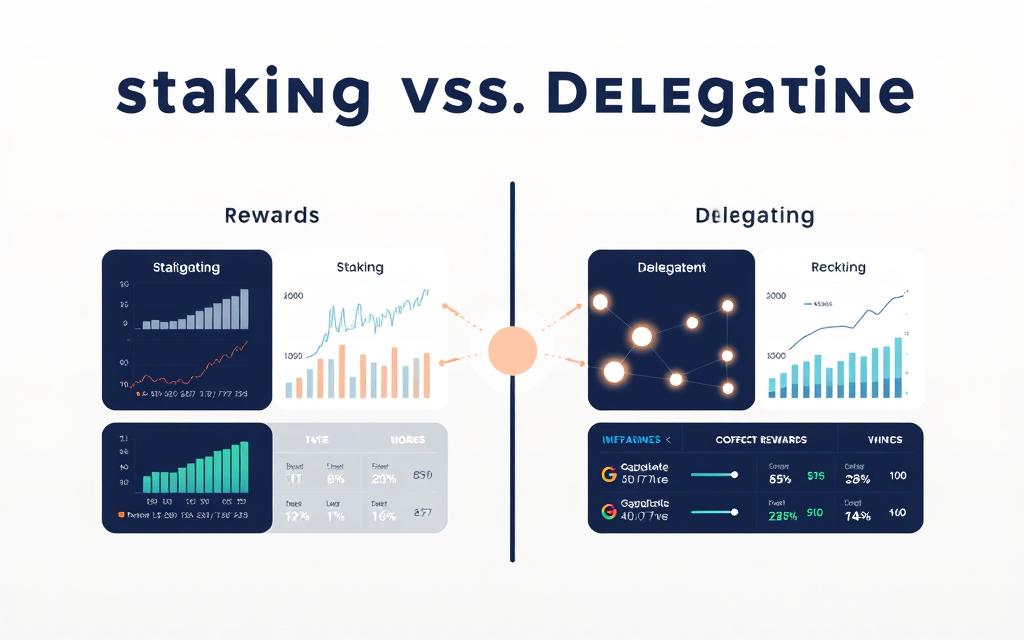Table of Contents
Many investors wonder whether participating in proof-of-stake networks involves identical processes. While both concepts relate to securing blockchain networks, they function differently.
Understanding these distinctions helps make informed decisions. Projects like MultiversX and NEAR Protocol showcase varied approaches to network participation.
Proof-of-stake systems offer energy-efficient alternatives to traditional mining. This advantage makes them increasingly popular among eco-conscious users.
This guide clarifies key differences between these mechanisms. You’ll discover how each method impacts rewards, responsibilities, and technical requirements.
Introduction to Staking and Delegating in Crypto
Active involvement in securing digital ledgers takes distinct forms across protocols. Proof-of-work systems like Bitcoin require massive computational power, while proof-of-stake alternatives prioritize capital commitment.
Energy efficiency separates these approaches dramatically. PoS networks consume 70% less electricity than PoW chains, making them sustainable choices.
Validators form the backbone of PoS ecosystems. These participants verify transactions, propose blocks, and maintain network integrity through locked funds.
MultiversX demonstrates scalability advantages with 15,000 TPS capacity. Its architecture contrasts sharply with Bitcoin’s 7 TPS limit.
| Feature | Proof-of-Work | Proof-of-Stake |
|---|---|---|
| Energy Use | High | Low |
| Hardware | ASIC Miners | Standard Servers |
| Participation | Competitive | Stake-Based |
| Example | Bitcoin | NEAR Protocol |
NEAR Protocol showcases rapid validator activation. New participants join within two epochs, ensuring fluid blockchain governance.
Direct staking demands significant resource allocation. MultiversX requires 2,500 eGold for validator status versus just 1 eGold for delegation.
Delegation offers accessible entry points. Users support network security without operating infrastructure, earning proportional rewards.
Staking vs. Delegating: Key Differences
Proof-of-stake networks offer two primary participation methods with different commitments. Each approach impacts rewards, responsibilities, and technical requirements uniquely.
What Is Staking in Crypto?
Staking involves actively operating a node to secure the blockchain. Participants lock capital as collateral to validate transactions.
MultiversX requires 2,500 eGold for validator status. This high barrier ensures only committed parties maintain network integrity.
Running a node demands technical expertise. Validators must manage server uptime, software updates, and slashing risks.
What Is Delegating in Crypto?
Delegation allows passive participation by assigning funds to trusted validators. Users contribute to security without node maintenance.
Platforms like NEAR Protocol enable delegation with minimal amounts—1 eGold suffices. Seat prices fluctuate based on demand.
Rewards distribute proportionally. Smart contract systems automate payouts, reducing manual oversight.
Choosing between methods depends on capital, technical skills, and desired involvement. Both strengthen decentralized ecosystems differently.
How Staking Works in Proof of Stake Blockchains
Validator nodes power proof-of-stake networks by processing transactions. These nodes lock coins as collateral to validate blocks, ensuring network security. MultiversX requires 2,500 eGold plus server infrastructure to run validator node operations.

Validator Nodes and Their Role
Operating a validator node demands robust hardware and uptime. ProCrypto’s nodes maintain 99.9% reliability, minimizing slashing risks. Technical requirements include:
- Dedicated servers with 16GB+ RAM
- SSD storage for fast block processing
- NEAR CLI tools for stake management
near stake tokens validator_id amount
Staking Pools and Collective Participation
Staking pools let users combine resources for shared rewards. Participants delegate funds to trusted operators, reducing individual risk. MultiversX pools optimize APR by distributing rewards across multiple nodes.
NEAR offers flexible pool options. Users choose between direct staking or pooled participation, balancing control and convenience.
How Delegating Works in Proof of Stake Blockchains
Participating in blockchain security through delegation offers a hands-off approach for token holders. This method lets users support network validation without operating infrastructure. Platforms like NEAR Protocol automate rewards via smart contract systems.
Choosing a Validator to Delegate To
Selecting reliable node operators requires evaluating key performance metrics. Reputable validators maintain high uptime while offering competitive commission rates.
| Selection Factor | Ideal Benchmark | Risk Indicator |
|---|---|---|
| Uptime | >99% | |
| Commission | 5-10% | >20% |
| Delegated Amount | 1M+ tokens | |
| Penalty History | 0 slashing events | >3 events |
MultiversX displays validator stats directly in its wallet interface. Users compare historical performance before assigning funds.
The Delegation Process and Smart Contracts
Modern platforms simplify participation through intuitive steps:
- Connect a secure wallet like NEAR Wallet
- Browse available staking pool options
- Select preferred validator based on metrics
- Approve the automated smart contract
- Monitor rewards through dashboard analytics
Security best practices include:
- Using UFO VPN for public Wi-Fi access
- Verifying contract addresses manually
- Enabling two-factor authentication
NEAR Protocol processes payouts every epoch (12 hours). MultiversX allows daily reward claims through its web interface.
Is Staking and Delegating Crypto the Same Thing?
Digital asset holders face fundamental choices when supporting proof-of-stake systems. While both methods strengthen blockchain security, their operational models differ substantially.

Control versus convenience defines the primary spectrum. Running validator nodes offers complete autonomy over operations, while delegation provides passive income streams through trusted third parties.
Capital requirements show dramatic variance. Some networks demand $250,000+ for validator status, whereas platforms like Cardano allow participation with just $100 through delegation pools.
Risk exposure splits along technical lines:
- Validators face slashing penalties for downtime
- Delegators risk lower rewards from poor validator performance
Network impact varies by participation type. Direct staking contributes immediately to security, while pooled funds exert influence through validator selection.
Tax treatment remains similar across both methods in most jurisdictions. Rewards typically qualify as taxable income regardless of participation style.
MultiversX’s upcoming Phase 4 update introduces new slashing parameters, highlighting how protocol changes affect risk profiles differently for active versus passive participants.
Rewards: Staking vs. Delegating
Yield generation strategies differ significantly between active and passive proof-of-stake participation. Networks like MultiversX adjust APRs based on validator performance, while NEAR Protocol offers fixed delegation yields.
How Staking Rewards Are Calculated
Direct validators earn rewards through complex algorithms. These consider staked amount, network uptime, and transaction volume processed.
MultiversX shows APR degradation when single nodes receive excessive top-ups. This mechanism prevents centralization while maintaining fair distribution.
How Delegating Rewards Are Calculated
Passive participants receive proportional shares from validator rewards. NEAR’s delegation yields average 10-12% annually after fees.
Commission structures impact final returns dramatically:
- ProCrypto charges 15% on earned yields
- Community pools often have 5-8% fees
- Some validators offer zero-fee promotions

| Factor | Staking | Delegating |
|---|---|---|
| Base APR | 8-15% | 10-12% |
| Commission | None | 5-15% |
| Compounding | Manual | Automatic |
| Minimum | 2,500 eGold | 1 eGold |
Tax authorities treat both methods similarly. The IRS classifies all earnings as ordinary income, requiring annual reporting.
Withdrawal timelines vary by network. NEAR imposes 2-3 epoch delays, while some pool solutions offer instant access to funds.
Risks and Security Considerations
Network participants must weigh potential drawbacks alongside rewards when securing proof-of-stake chains. Both validators and delegators face distinct vulnerabilities that require proactive management.

Validator Operational Hazards
Running nodes exposes operators to slashing penalties. MultiversX Phase 4 proposes 5-10% stake reductions for:
- Downtime exceeding protocol thresholds
- Double-signing blocks
- Network protocol violations
NEAR maintains stricter standards with 0.01% historical penalty rates. Geographic server distribution minimizes risk from regional outages.
Delegator Exposure Points
Passive participants face different challenges:
| Threat | Mitigation Strategy |
|---|---|
| Validator insolvency | Diversify across multiple pools |
| Commission fee hikes | Select validators with rate locks |
| Smart contract bugs | Use audited platforms like NEAR |
Multi-signature wallets add protection for funds. UFO VPN encryption secures transactions during delegation.
Lock-up periods introduce time sensitivity. Some networks impose 72-hour withdrawal delays, requiring liquidity planning.
Regular validator performance reviews reduce risk. Monitoring tools track uptime and reward consistency across epochs.
Technical Requirements for Staking and Delegating
Technical preparations vary significantly between direct participation and passive involvement in proof-of-stake networks. Each approach demands specific infrastructure investments and capital commitments.
Hardware and Software for Running a Validator Node
Enterprise-grade equipment powers reliable validator node operations. MultiversX mandates 16-core processors with 64GB RAM minimum for consistent performance.
Successful participants often invest in:
- Dedicated server racks with backup power
- Enterprise SSD storage (2TB+)
- Redundant internet connections
“NEAR Protocol testnets allow practice deployments before mainnet activation”
Staking-as-a-Service solutions reduce hardware burdens. These platforms manage infrastructure for 15-20% commission fees.
Minimum Staking Amounts and Lock-Up Periods
Capital requirements show dramatic variance across pos networks. Ethereum demands 32 ETH (≈$100,000) to run validator node operations.
Comparative minimums:
| Network | Amount | Unstaking Period |
|---|---|---|
| MultiversX | 2,500 eGold | 10 days |
| NEAR | 1 NEAR | 72 hours |
| Solana | 1 SOL | 2-3 days |
Lock-up period durations affect liquidity planning. Some platforms permit partial withdrawals during bonding intervals.
Test environments help users evaluate requirements. NEAR’s sandbox mode simulates real network conditions without capital risk.
Popular Blockchains That Support Staking and Delegating
Leading proof-of-stake networks provide diverse participation models for users. Each blockchain implements unique reward structures and technical requirements.
MultiversX stands out with 3,200+ active validators. Its sharded architecture enables high throughput while maintaining security.
NEAR Protocol utilizes factory contracts for staking pool creation. Over 100 pools operate with varying commission structures.
Ethereum 2.0 offers 4% average yields. The merge transition shifted its consensus mechanism to pos validation.
| Platform | Validators/Pools | Average APR |
|---|---|---|
| MultiversX | 3,200+ | 12% |
| NEAR | 100+ | 10% |
| Ethereum | 400,000+ | 4% |
Emerging chains introduce innovative tokenomics. Some implement interchain security for shared validation resources.
Governance participation varies across platforms. Certain networks grant voting rights proportional to staked tokens.
Institutional adoption grows steadily. Custodial solutions now support enterprise-grade staking operations.
Choosing Between Staking and Delegating
Retail investors overwhelmingly prefer delegation despite higher validator rewards. Data shows 92% choose passive participation due to lower technical barriers. This contrasts sharply with professional validators who run validator operations at $18k average setup costs.
- Technical skill vs capital availability
- Expected ROI timelines
- Portfolio diversification needs
- Network unstaking periods
Direct validation offers 15-20% APY but demands enterprise hardware. Delegation yields 10-12% after fees with minimal requirements. MultiversX shows 18-month breakeven for professional setups versus immediate returns through pools.
Smart diversification balances risk across methods. Allocate 70% to trusted validators and 30% to self-staked positions. This hedges against single-point failures while maintaining yield potential.
“Always calculate exit liquidity needs before locking funds”
Validator profitability calculators help project earnings. Input your stake size, network inflation rates, and commission structures. NEAR Protocol’s dashboard automatically adjusts projections based on real-time metrics.
Remember that unstaking periods range 2-10 days across networks. Plan withdrawals around market conditions to avoid forced liquidations during volatility.
Conclusion
Understanding participation methods helps maximize blockchain benefits. Staking requires technical skill, while delegation offers passive rewards. Both strengthen network security differently.
Prioritize safety. Research validator performance and use trusted platforms. The PoS landscape grows rapidly, with innovations like shared validation.
Match your strategy to goals. Active users gain control, while passive investors prefer simplicity. Explore blockchain rewards to start securely.
FAQ
What is the main difference between staking and delegating?
Staking involves locking up tokens to support blockchain operations directly, often by running a validator node. Delegating means assigning tokens to an existing validator, letting them handle the technical work while earning a share of rewards.
Do I need technical skills to delegate my tokens?
No. Delegating requires minimal technical knowledge since validators manage the infrastructure. Users only need a compatible wallet and enough tokens to meet the minimum delegation threshold.
How are rewards calculated for stakers versus delegators?
Stakers earn rewards based on their validator’s performance, including uptime and transaction validation. Delegators receive a portion of these rewards minus the validator’s commission fee.
What risks do delegators face?
Delegators risk reduced earnings if their chosen validator underperforms or gets penalized (slashed). Unlike stakers, they don’t lose tokens directly but may see lower returns.
Can I unstake or undelegate tokens immediately?
Most blockchains enforce a lock-up period before tokens become available. Unstaking or undelegating may take days or weeks, depending on the network’s rules.
Which blockchains support both staking and delegating?
Popular networks like Ethereum (post-Merge), Solana, Cardano, and Polkadot allow both options. Each has unique requirements for minimum token amounts and reward structures.
Is running a validator node profitable?
Profitability depends on hardware costs, token value, and network demand. High-performing validators earn more but must maintain 24/7 uptime and robust security.
How do smart contracts impact delegation?
Smart contracts automate reward distribution between validators and delegators, ensuring transparency. They also enforce slashing conditions if validators break protocol rules.









